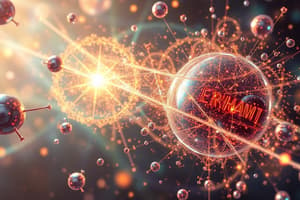Podcast
Questions and Answers
What is the primary intermolecular force responsible for the condensed states of nonpolar substances?
What is the primary intermolecular force responsible for the condensed states of nonpolar substances?
- Dipole-dipole force
- Dispersion force (correct)
- Ionic bond
- Hydrogen bond
What causes the attraction between nonpolar particles due to dispersion forces?
What causes the attraction between nonpolar particles due to dispersion forces?
- High electronegativity of the elements
- Synchronized motion of electrons in close atoms (correct)
- Presence of lone electron pairs on atoms
- Permanent dipole moments in the atoms
Which type of intermolecular force is stronger than dispersion forces and involves an uneven distribution of electrons?
Which type of intermolecular force is stronger than dispersion forces and involves an uneven distribution of electrons?
- Ionic bond
- Van der Waals forces
- Dipole-dipole forces (correct)
- Hydrogen bond
What special type of dipole-dipole force arises between molecules with H atoms bonded to highly electronegative atoms like N, O, or F?
What special type of dipole-dipole force arises between molecules with H atoms bonded to highly electronegative atoms like N, O, or F?
What is withdrawn from hydrogen atoms in H-N, H-O, and H-F bonds, leading to the formation of a hydrogen bond?
What is withdrawn from hydrogen atoms in H-N, H-O, and H-F bonds, leading to the formation of a hydrogen bond?
According to the kinetic molecular model of matter, what is the relationship between the average kinetic energy of particles and the absolute temperature?
According to the kinetic molecular model of matter, what is the relationship between the average kinetic energy of particles and the absolute temperature?
Which state of matter has particles that exhibit the slowest speed according to the kinetic molecular model?
Which state of matter has particles that exhibit the slowest speed according to the kinetic molecular model?
What does the kinetic molecular theory state about the volume of individual particles in gases?
What does the kinetic molecular theory state about the volume of individual particles in gases?
Which assumption in the kinetic molecular theory of gases explains why gases can be compressed easily?
Which assumption in the kinetic molecular theory of gases explains why gases can be compressed easily?
How can the behavior of gases and liquids be explained according to the kinetic molecular model?
How can the behavior of gases and liquids be explained according to the kinetic molecular model?
Flashcards are hidden until you start studying




